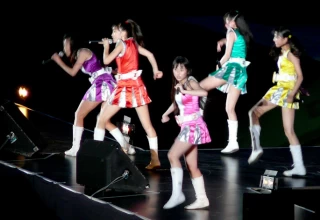In Japan, a junior idol (ジュニアアイドル junia aidoru?), alternatively chidol (チャイドル chaidoru?) or low teen idol (ローティーンアイドル rōtīn aidoru?), is primarily defined as a child or early teenager pursuing a career as a photographic model. Generally, this means gravure, or "cheesecake", fully clothed shots; but, junior idols can, and some do, eventually enter the AV industry. Child actors, musicians, and J-pop singers (whose musical genre is often termed idol pop) can also be considered junior idols and are often featured in photobooks and image DVDs.
Female fashion models (not to be confused with glamour models, including gravure idols) also begin their careers typically at age 13–15, but are usually not considered junior idols. Child models, whose careers are usually over by their early teenage years, are also not usually considered junior idols.

Definition
There exists no clear set of guidelines regarding the age at which an individual becomes a junior idol: Yumi Adachi, for instance, started her modeling career at age two and many other idols have starred in image DVDs at the ages of three, four and five. The majority of junior idols belong to specialized talent agencies, some of which offer acting and voice training and are geared towards the production of television commercials, photobooks, and related materials. Though sources indicate revenue is relatively low for photographic models, a number of idols (and their parents) see this activity as a gateway to more mainstream media roles. These transitions are indeed frequent, one example being the case of Saaya Irie who was cast into the live action adaptation of the popular anime series Hell Girl and several other television programs. Conversely, some aspiring idols eventually find themselves pursuing less and less mainstream work.
History
The trend of junior idols dates back to the mid-1990s, a period marked by significant increase in the number of child models and works involving individuals in that age range. The term chidol, a neologism of the words "child" and "idol", was coined by columnist Akio Nakamori to describe this new phenomena. Eventually, this term fell out of use and was replaced by "Junior Idol". Compared to chidol, the term "junior idol" plays down the association with age and lends some credibility to the industry associating it with the legitimate mainstream idol culture in Japan.
Distribution
Content is available in a plethora of formats, usually physical goods such as bond photobooks, CDs and DVDs, but also digital content in the form of Portable Document Format books, JPEG photo sets, high resolution movie clips, etc. To promote a particular idol, or to celebrate the release of a specific title, certain stores hold special events where fans get to meet the idols, shake hands with them, obtain autographs or take photographs, either polaroids or pictures taken with the customers' own cameras, in accordance with the amount of money spent on related goods (either regular DVDs, photobooks, etc., or multiple copies of the same title).
Concerning the contents of the titles put on sale, these include, in general terms, pictures or footage of the idols trying out a variety of outfits, such as school uniforms, bathing suits, gym clothes, yukata or even maid, police and anime-inspired costumes.
Some services providers, such as Imouto Club (清純いもうと倶楽部 Seijun Imōto Kurabu?)—a subscription-based website—also feature short radio and movie dramas, available for download and later purchase on DVD.
From Wikipedia
Tags: aidoru
Female fashion models (not to be confused with glamour models, including gravure idols) also begin their careers typically at age 13–15, but are usually not considered junior idols. Child models, whose careers are usually over by their early teenage years, are also not usually considered junior idols.

Definition
There exists no clear set of guidelines regarding the age at which an individual becomes a junior idol: Yumi Adachi, for instance, started her modeling career at age two and many other idols have starred in image DVDs at the ages of three, four and five. The majority of junior idols belong to specialized talent agencies, some of which offer acting and voice training and are geared towards the production of television commercials, photobooks, and related materials. Though sources indicate revenue is relatively low for photographic models, a number of idols (and their parents) see this activity as a gateway to more mainstream media roles. These transitions are indeed frequent, one example being the case of Saaya Irie who was cast into the live action adaptation of the popular anime series Hell Girl and several other television programs. Conversely, some aspiring idols eventually find themselves pursuing less and less mainstream work.
History
The trend of junior idols dates back to the mid-1990s, a period marked by significant increase in the number of child models and works involving individuals in that age range. The term chidol, a neologism of the words "child" and "idol", was coined by columnist Akio Nakamori to describe this new phenomena. Eventually, this term fell out of use and was replaced by "Junior Idol". Compared to chidol, the term "junior idol" plays down the association with age and lends some credibility to the industry associating it with the legitimate mainstream idol culture in Japan.
Distribution
Content is available in a plethora of formats, usually physical goods such as bond photobooks, CDs and DVDs, but also digital content in the form of Portable Document Format books, JPEG photo sets, high resolution movie clips, etc. To promote a particular idol, or to celebrate the release of a specific title, certain stores hold special events where fans get to meet the idols, shake hands with them, obtain autographs or take photographs, either polaroids or pictures taken with the customers' own cameras, in accordance with the amount of money spent on related goods (either regular DVDs, photobooks, etc., or multiple copies of the same title).
Concerning the contents of the titles put on sale, these include, in general terms, pictures or footage of the idols trying out a variety of outfits, such as school uniforms, bathing suits, gym clothes, yukata or even maid, police and anime-inspired costumes.
Some services providers, such as Imouto Club (清純いもうと倶楽部 Seijun Imōto Kurabu?)—a subscription-based website—also feature short radio and movie dramas, available for download and later purchase on DVD.
From Wikipedia
Tags: aidoru
Information
Users of Guests are not allowed to comment this publication.
Users of Guests are not allowed to comment this publication.
All rights to the products, photos and video - belong to their creators. We are not a dealer and do not sell products - all purchases you make movies the owners or their representatives. We do not store any video on our server. All the products are located at the owners or their dealers. All movies are legal and allowed the free market - submit complaints to the video their producers!












